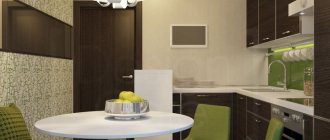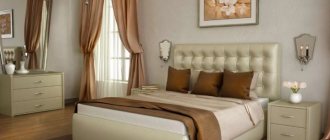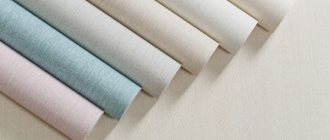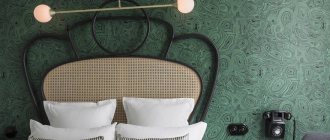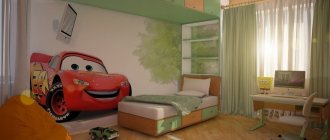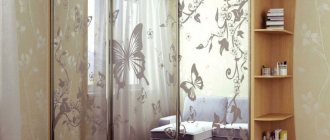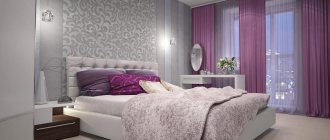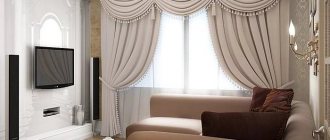A cozy interior necessarily means beautifully decorated walls. To decorate them, you can use paint, panels and other materials, but the most popular option is wallpaper. They play a serious role in the perception of the entire interior as a whole, so it is important to choose their appearance correctly.
In addition, you need to pay attention to performance characteristics. We will discuss all these nuances in detail in the article.
What to consider when choosing quality wallpaper
Of course, the wallpaper should match the style of the interior and look harmonious, but an equally important factor is its quality. Wallpaper from an unscrupulous manufacturer will last you only a short time, so the first thing you need to pay attention to is:
- Environmental friendliness. Wallpaper must be made from safe materials.
- Moisture resistance. This is especially important for the kitchen and children's room.
- Density.
- Easy to care for.
- Resistance to fading and abrasion.
- Fire resistance.
Good wallpaper that meets all of the above criteria may cost more than lower-quality analogues, but in the future you will feel that they are fully worth their cost. They will not have to be re-glued for many years.
Paper wallpaper
The most common wallpaper. They can have one or two layers. The choice of paper wallpaper is huge: ordinary smooth, with three-dimensional patterns and designs, corrugated. When choosing, pay attention to the weight - the heavier the roll, the better the quality of the wallpaper.
This type of wallpaper is the cheapest, but also the most unreliable.
Non-woven wallpaper
They combine the advantages of paper and vinyl wallpaper. The composition is 70% cellulose, the rest is connecting materials. Thanks to this, the wallpaper acquires increased density without losing breathability and practicality.
As a rule, the surface of non-woven wallpaper is embossed. If you want to transform the interior, they can be easily repainted several times. Also, such wallpapers initially have an adhesive layer, which simplifies their gluing.
Types by gluing methods
They are formed based on the type of wallpaper and the condition of the walls. There are three most common methods of gluing canvases:
- Butt. This method is effective only on flat surfaces and for dense products: non-woven, embossed, vinyl and silk-screen printing. This is his minus. And the advantage lies in the speed and high quality of the result.
- Overlapping. An excellent method for wallpaper with medium to low thickness. It can be used to hide modest defects on the walls. It is optimal for paper products. Its disadvantages are long work and scrupulous adjustment of the image. Be sure to cut off the edge and combine the two canvases.
- Image offset.
When deciding which wallpaper is best to choose, be sure to take into account what kind of pattern it has and its versions of its combination. Here are the following variations:
- Universal. The location of the picture does not matter.
- Straight joint. We glue the parts of the picture side by side at identical heights.
- Offset joint. The shift occurs in each subsequent sheet.
- Displacement + revolution. We turn every second canvas 180 degrees.
You might be interested
How to glue wallpaper correctly. The foreman shares his experience. Finishing work. Stages of finishing work. How can you save money when renovating?
What to look for when choosing wallpaper
The first step is to decide for which room you are choosing wallpaper. Their characteristics must match the room. For example, for a child's room, the best option would be wear-resistant, washable wallpaper. Also consider whether you plan to repaint the walls in the future, or if you're ready to just change the wallpaper.
Pay attention to the symbols on the label and, of course, choose wallpaper that matches the interior.
Symbols on wallpaper
Be sure to read the wallpaper label. All information is indicated there: the level of moisture and light resistance, care rules, gluing features. When calculating the number of rolls, you will also have to refer to the markings.
There are the following letter designations that provide information about the type of wallpaper:
- A – acrylic;
- B – paper;
- BB – foamed vinyl;
- PV – flat vinyl;
- RV – embossed vinyl;
- TKS – textile wallpaper;
- STR – structural wallpaper for painting;
- STL – glass wallpaper.
The width and length of the roll can be found on the label. According to the standard, the length is 10 m and the width is 0.53 m or 1.06 m.
Is it worth saving when choosing wallpaper?
One of the common mistakes is buying the cheapest wallpaper. It is worth remembering that the better the quality of the wallpaper, the more durable and beautiful the repair you will get. Wallpaper is the basis of the room, its background, which can be either accent or neutral. In any case, low-quality and tasteless wallpaper is always noticeable, no matter what function it serves, and even expensive furniture will not save the situation.
In the store it may seem that cheap wallpaper is not so bad. However, when gluing them, you will most likely encounter many problems: they can tear, wrinkle, and highlight the unevenness of the walls. Over time, the design often fades or is completely erased, and the wallpaper peels off.
Preparing the walls
In order not to be disappointed with the final result, you need to clearly know how to prepare walls for pasting. To treat the surface you will need a spray bottle with water, a spatula, and unnecessary rags.
To remove the old layer of wallpaper, you need to spray it on it and wait until the canvas gets wet and begins to move away from the wall. To enhance the effect, use warm water and soap solution.
Then the canvases begin to be torn off with a spatula or knife. If the wallpaper comes off well, you can remove it by hand.
Gaps, cracks and unevenness may be hidden behind old layers. They must be removed with putty. Then the walls are plastered and primed.
After this treatment, it is better to transfer the pasting to the next day so that the applied layers dry thoroughly.
When decorating walls with non-woven and vinyl wallpaper, plaster and primer are usually not carried out. The thickness of the canvas allows you to hide minor surface defects.
How to choose the right type of wallpaper
Another mistake is buying the wrong type of wallpaper. Consider the features of the room where you plan to glue them:
- You can choose any wallpaper for the living room and bedroom. Textile ones look especially interesting - they make the interior more expensive and elegant.
- It is best to glue vinyl wallpaper to the kitchen - it is easy to wash off any dirt from them, which cannot be said about their paper counterparts.
- The same rule applies to the hallway. There is a big risk of dirty shoes staining the wallpaper, so you need it to be moisture resistant.
- Sometimes wallpaper is even applied to the bathroom. Here, of course, you need to give preference to washable wallpaper; glass wallpaper is also suitable.
- In a children's room, it is most convenient to hang inexpensive paper wallpaper. Children often draw on the walls, so it won’t be a shame to change the finish. A good solution is to purchase glass wallpaper that can be repainted several times. Another interesting option is special wallpaper for drawing in the nursery. They come in three types: marker, chalk and coloring. In the first two cases, the drawings can be erased.
Chalk wallpaper is very practical not only in a children's room. For example, they can be used in the kitchen, sticking them next to the work area, and writing notes and recipes there.
What wallpaper to choose for the room?
What color should you choose wallpaper for your walls?
Color is perhaps the most important factor that subconsciously influences people's mood. How to choose the color of wallpaper so that it triggers the necessary processes in the brain that correspond to the purpose of your stay in a certain place in the house? The answers to this question have long been known.
The kitchen needs a color that stimulates the appetite, invigorates in the mornings and saturates with energy in the evenings. This is yellow. Good colors for the kitchen are beige and silver. They combine well with the energy of water. White color is also very favorable for the kitchen. It attracts a flow of positive energy. From the point of view of favorable energy, remember that kitchens with extravagant, provocative tones will be deprived of it. The only thing you can afford are bright splashes of one rich color, for example, red.
The hall needs to consciously create a friendly, peaceful environment as it gathers together. The desire to conflict will not arise when surrounded by green, beige or any other pastel color.
Deep blue color is very appropriate in an office or work area in a room. It stimulates brain function. When the eyes take in the color blue, mental work is done easily and quickly.
Beige, olive, peach are ideal tones for the bedroom, especially for those parts of it where your eyes look when you wake up. In the bedroom you can leave a bright, exciting corner of red or crimson, but it should be localized, say, on one of the walls, for example, behind the head of the bed. The point is that it will be in front of your eyes only during waking moments, it will help you tune into a passionate mood at the right moment, but it will not interfere with peace before bed.
- It's blowing from the window - what to do?
The child's psyche is a very subtle instrument. Therefore, the main colors in the children's area can be calm green, yellow, and milky. Bright stimulating colors can only be present in the play area, and even then in a very dosed form. Limit depressing purple, frightening black, exciting red as much as possible not only in the children's room, but also in any part of the house.
We've figured out the basic colors for each room. But what if you find background wallpaper of the same color boring and want more interesting color schemes? In this case, we arm ourselves with the rules of color combinations. How to choose wallpaper of two colors? Just like in clothes, for example.
A harmonious combination of colors can be achieved by adding any of the following to the main color:
- white + any existing color;
- red + green, blue, golden, yellow, gray;
- pink + gray, brown, burgundy;
- orange + green, purple, brown, light blue;
- yellow + green, golden, light green, brown;
- blue + blue, orange, red, brown;
- blue + red, gray, golden, silver, burgundy;
- purple + orange, green, golden, yellow;
- gray + yellow, black, green, blue, red, pink.
If you have difficulty with color combinations, you don’t have a table at hand, and you doubt whether this or that color matches another color, remember that nature has a universal hint. All color combinations that exist in nature are a priori harmonious. Like, for example, the orange fruit of an orange and its green branch with leaves. It's beautiful! Feel free to combine colors and create a unique style for your home.
How to choose the right wallpaper for the ceiling?
Wallpaper for the ceiling is still popular and competes with other types of “indoor sky” design. And all because this is an inexpensive way to complete the room, without limiting yourself to the usual whitewashing or painting of the ceiling. And although the most advantageous color of the ceiling is still white, you are free to play a little with colors and textures, bringing to life your own or the designer’s original ideas.
3 types of wallpaper are suitable for the ceiling, namely: foamed vinyl, structural wallpaper for painting and glass wallpaper.
How to choose wallpaper to match the color of the furniture?
The color of the furniture and the color of the wallpaper should look harmonious. It is important to achieve the effect so that the furniture does not merge with the walls. This means that a minimum contrast between them is required.
You cannot violate the principle that says: warm tones are combined with warm tones, and cold tones are combined with cold tones. This means that furniture and wallpaper should not conflict in this sense.
If the furniture is dark, then the walls are light. Accents on the walls are also appropriate only through paintings, but not through wallpaper designs. You can't argue with that.
If the furniture is white, then there are many options. And light shaded, and dark, and bright wallpaper - everything will do. White color is universal.
If the furniture is brown, you need wallpaper in warm colors.
If the furniture is multi-colored, for example, in the kitchen or children's room, choose wallpaper in pastel colors.
How to choose wallpaper for your interior?
Remember that it is easier to match the wallpaper to the furniture than vice versa. Therefore, when starting a renovation, we dance away from the furniture in any case. Even if you haven't purchased it yet, try to imagine what it will be like (style, color) and where it will stand. Only after this can you figure out what wallpaper you will need.
Depending on whether you will decorate the walls with photographs, paintings, tapestries, you can select a wallpaper pattern. If you plan a rich additional decor, then background wallpaper is needed. If there is no additional decor, the gap can be filled with a rich wallpaper pattern.
- It's blowing from the window - what to do?
Do not forget that both the window composition and niches are important parts of the interior. When choosing wallpaper, try to imagine the whole picture. To make sure that you are doing everything correctly, try to look at your room from different angles: what will you see when entering the room from the door, and how will it look from the position of your workplace, and will everything look beautiful from everyone’s favorite sofa?
How to choose curtains for wallpaper?
It is imperative to design a window composition with an eye to the wallpaper of the room. They must be designed in the same style, and also be in harmony with each other in color and texture. In this matter, leading designers have developed certain rules for combining everything with everything. But for now we’re just gluing wallpaper, and we’ll start working on curtains, curtains, and roller blinds when we’ve completely prepared the walls and ceilings.
How to choose the appropriate shade when buying wallpaper
Poorly chosen wallpaper can ruin the entire impression of the room. Wallpaper should look harmonious in the interior and not stand out, unless, of course, you set yourself the goal of making one of the walls an accent wall. Even when wallpaper becomes the highlight of the decor, you need to remember the rules for combining colors and the features of the room.
When choosing a wallpaper color, pay attention to:
- Room size. Wallpaper can greatly change the visual perception of space. In small rooms you should not make black walls, as the room will become even cramped and uncomfortable. It is better to choose light colors - they will create a feeling of spaciousness and enliven the room. White, beige, and light gray will help create a relaxed and calm atmosphere. These are neutral colors that are also great for creating a subtle backdrop, which will allow all the attention to be directed to the furniture. In spacious rooms, it is quite possible to hang dark, even black, wallpaper. However, you still shouldn’t decorate all the walls in this way - one or two will be enough, otherwise the situation will be tense;
- Color saturation. Wallpaper that is too bright should only be hung in large rooms and as a single accent, otherwise it will start to irritate. They can be used to decorate the wall behind the bed in the bedroom - it is rarely in sight, so bright wallpaper will not bother you.
- Lighting and window placement. North-facing rooms always lack natural light. Wallpaper in warm colors will help make them more comfortable: beige, yellow, peach, soft pink, orange and the like. Cold tones, on the contrary, will be appropriate in rooms on the sunny side.
- Wallpaper density. If you choose light wallpaper, it can often shine through, emphasizing the imperfections and unevenness of the walls. In this case, before gluing them, the surface must be painted with water-based paint.
Wallpaper combination
There are no strict rules and criteria in this matter. In many ways, its decision depends on the conditions in the room, the types and colors of furniture in it, etc.
Let me give just a few examples:
- If you have a two-color set, the wallpaper should have a lighter tone. You can paste the walls in colors opposite to the parts of the set.
- Dividing a wall into two horizontal sides. The upper one has lighter tones, the lower one has darker colors, or panels are arranged.
- Zoning of space. A game of shadows. This is the best option for plain wallpaper of different colors. Often he settles down in the bedroom. One of them has light gray tones. And the color of the sleeping area is deep and rich.
Selecting a suitable pattern when purchasing wallpaper
A few tips on how to choose the right wallpaper pattern:
- Use small patterns only on one wall. Do not wallpaper the entire room with such a pattern - it will dazzle your eyes.
- Dark wallpaper with a large pattern on one of the walls is a win-win way to visually lengthen a room.
- Bright wallpaper should be supported with interior items of the same color. For example, pair a red accent wall with a small red chair.
- Wallpaper with horizontal stripes expands the walls, and wallpaper with vertical stripes visually lifts them up.
Wallpaper with flowers, forest or fruits - nature theme
The theme of nature is increasingly appearing in bedrooms, as it adds coziness to the room and warms the atmosphere. Nature in interior design and furnishings takes the form of more than just wooden floors or furniture.
More and more often we see nature on the walls. This trend can be seen in wallpaper design. Various elements related to nature are increasingly being chosen as a decorative element for bedrooms or youth wallpaper.
Decorative wallpaper - trees can be anywhere
Wood wallpaper is one of the most popular wall decorations nowadays. Wood is a theme that gives interiors a homey feel and warmth. This is why this pattern appears in different forms in rooms. Wood wallpaper usually comes in muted tones and shades of gray and white. This makes them particularly suitable for Scandinavian interiors, where an interesting accent adds freshness and a slightly different character.
Wood-look wallpaper is an excellent base for many different pieces of furniture and accessories. The colors and patterns of the wallpaper match both white furniture and furniture made of light or dark wood. The remaining wall colors should be kept in the same tone as the wallpaper, then you will have the impression of a more open and bright room.
The forest could be anywhere
You can also use a wood motif by choosing to decorate the walls with a specific wallpaper. The forest reminds us of peace and quiet. Such wallpaper is especially relevant in small rooms with small windows.
Then the forest wallpaper acts as a “substitute” for the view from the window and creates the impression that the room is larger, brighter and more spacious. They can be in dark and light versions. In black and white they go well with bright colors of white and gray. In a darker version, usually in natural green tones, this forest wallpaper will be a wonderful complement to brick or wooden walls.
Wallpaper with flowers
Flowers are another natural motif that is also very often used in wallpaper production . This pattern may seem too aggressive to apply to a wall. Meanwhile, wallpaper with a floral pattern in muted colors will add character to the interior, which will be responsible for the friendly atmosphere in the room.
Wallpaper with flowers is a good way to emphasize the character of the interior. In romantic, warm bedrooms in soft pastel colors, pink and white flowers - especially peonies - are perfect. In both dark and light versions, pink color emphasizes the romantic character of the interior and gives the bedroom additional charm.
Wallpaper with flowers, composed of velor with gold or silver fittings, gives an interesting effect that may indicate the refined taste of the home owners.
Another option for decorating floral wallpaper in the bedroom is to use a richer color to match the other accessories visible in the room. Maybe:
- aquamarine shade,
- fuchsia color,
- mustard.
Thanks to this combination, we get a very stylish interior, reminiscent of the refined flair of an experienced designer. Using the right wallpaper with flowers , you can achieve this effect yourself, getting a beautiful modern design.
Wallpaper with animal designs
Rich colors are gradually returning to the interior. animals on wallpaper often reign in interiors . Flamingos are a kind of flower substitute. They are intended for people who want to maintain stylish colors in their interiors, but do not necessarily want to focus on a floral theme.
Flamingo wallpapers are usually combined with green leaves. Pink and green colors create an interesting combination that gives the interior an interesting character. Such wallpaper can be dark or light. Light shades go well with white or light wooden furniture.
They will decorate the room and give it a positive character and coziness. Flamingo wallpaper, available in darker tones, pairs perfectly with muted furniture colors such as:
- dark, dusty pink headboard,
- bottle green chair
- accessories in black or gold.
How to calculate the number of rolls before purchasing wallpaper
The final mistake is buying too many or too few rolls. To ensure you have enough wallpaper, you need:
- Calculate the total area of the room, subtract door and window openings from the resulting value.
- Divide the result by the area of the roll. It is indicated in the instructions or on the label.
- Add an extra roll. When gluing, you can ruin a certain amount of wallpaper, so to avoid having to buy it again, buy one roll in reserve.
Remember that wallpaper with patterns must be glued so that all the patterns match. Because of this, additional material will be required.
Choosing good wallpaper is not difficult, the main thing is to take into account all the nuances described in the article. If they are chosen correctly, they will definitely transform the interior and will delight the owners with beauty and quality for a long time.
Rule 6: Perspective on photo wallpaper
Properly selected photo wallpaper will significantly increase the size of the room
Photo wallpapers and photo wallpapers are different. Therefore, when covering a wall with macro photography of a flower, think about how the parameters of your tiny home will visually decrease. But an image that brings light and perspective is ideal for decorating a wall in a small room.
A paved path leads somewhere into the distance, and yet no one leaves the room
Some tips for hanging photo wallpaper
A few words about how to beautifully hang photo wallpaper:
- Remove the old coating, including any remaining adhesive;
- Use putty to fill in all the unevenness – for an impeccable result you need a perfectly flat surface;
- Apply primer to the wall in two layers to ensure reliable adhesion of the two surfaces;
- Lay the photo wallpaper on the floor, face down, and carefully mark it;
- Start gluing from a corner or from a window - this will be the starting point;
- Avoid drafts when gluing.
The image can also be in black and white
Following my advice, you can hang photo wallpaper with your own hands. Even if you've never done this before.
